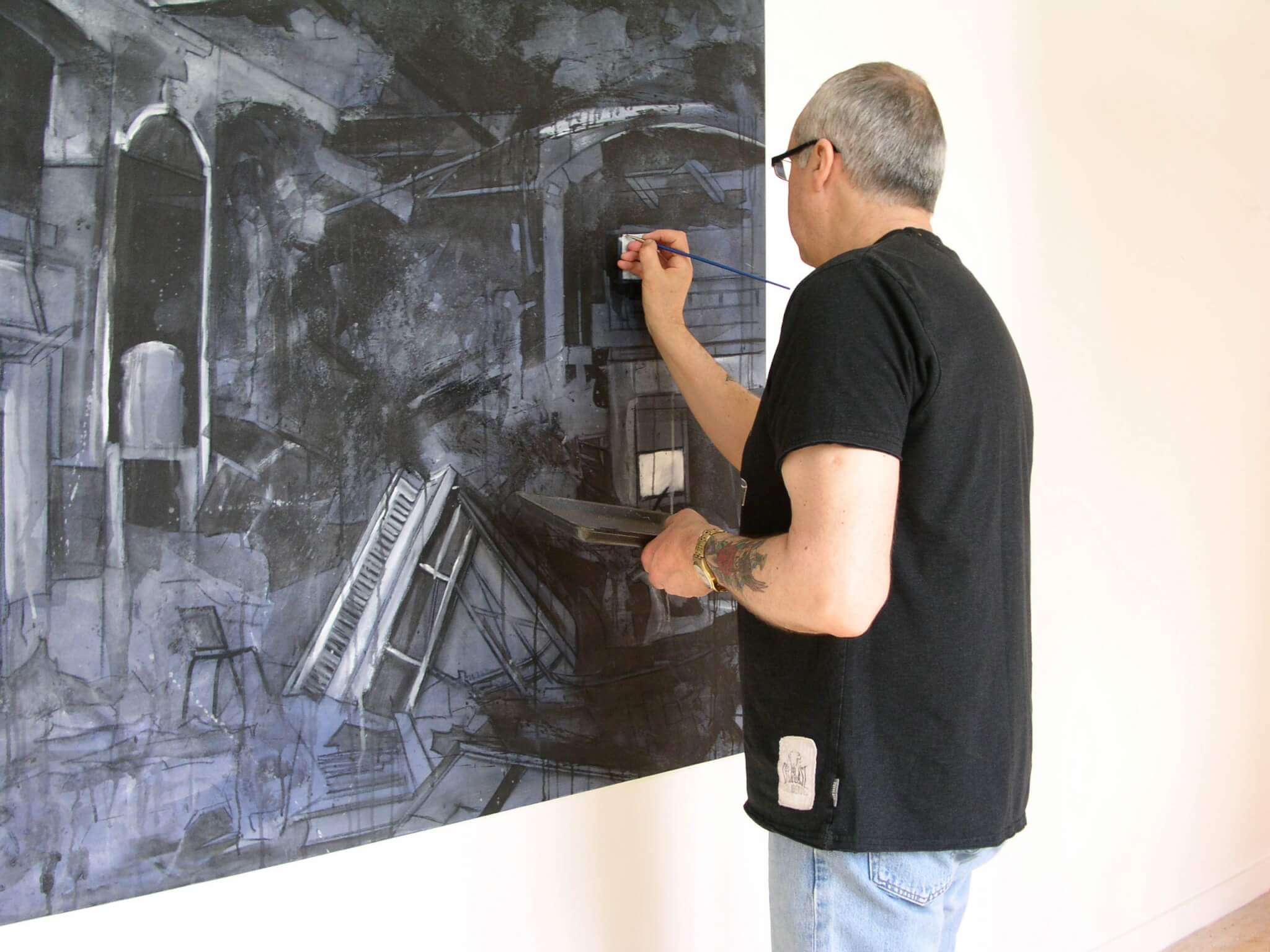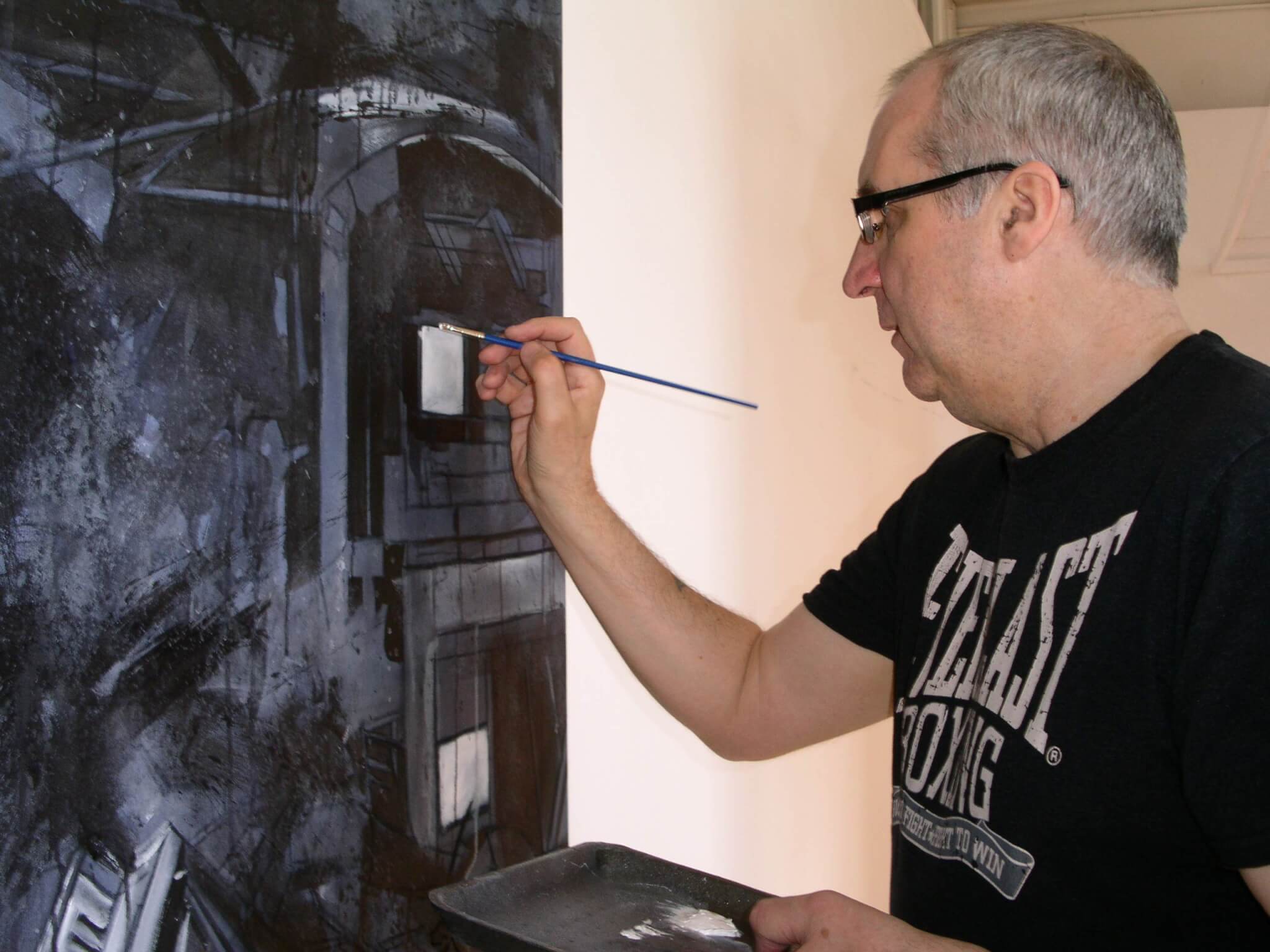WILLIAM SERRIDGE Artist’s Statement

Technique
My canvases are usually painted using the traditional method of squaring up, and drawing out with charcoal, with a tonal underpainting – as practiced in Renaissance painting. However, although many of my paintings are in the more traditional oil, I now prefer to work almost exclusively in acrylic – partly for its rapid drying time, and general convenience; but mainly for its appearance, ‘feel,’ and versatility.
I see my working process as a triangle: the original scene, liable to change with time; the instant, photographic representation of the scene, with each element of it ‘fixed’ simultaneously in time; and my painted representation of the scene, with each part of the composition produced at different times – in effect, representing the passage of time itself; and I feel that this gives my work a sense of life.
Choice of Greyscale / Monochrome
The benefits of employing a monochrome underpainting for a polychromatic painting are manifold: the process can be broken down into different stages. This means that things can get done quickly and separately. It also decreases the chances of error or failure at a later stage: the colour being added once the composition, drawing-out, and underpainting have been completed. Although some of my monochromatic paintings are executed in a variety of shades of a certain colour, they are now usually painted in greyscale. This has been my chosen method since 2014 – in the final year of my BA (Hons) Fine Arts Degree.
I prefer greyscale because of its proliferation of black. Black is the boldest, most powerful hue, and the most intense against a white background, which is why designers and advertisers often use it for greater effect. Black and white photography still exists for much the same reason, as it can be much more striking than a photograph in colour, which can be over-stimulating and distracting from the message to be conveyed, and the actual composition – making tonal contrasts more apparent and striking. I use greyscale in my painting for the same reasons.
Black is associated with many things, although almost all of them have negative connotations, because humankind instinctively fears the darkness. Black also represents space, specifically outer space and infinite space; and there is also a mystery to things that cannot be defined, or seen. Black accentuates anything with mysterious or indefinable qualities. It is interesting to note that most black pigments are natural pigments similar to graphite or coal, called amorphous carbon; and almost all black paint is made from some kind of burnt materials (the notable exception being synthetic iron oxide, a more recently developed black pigment). In some cases, black pigment is made from charred animal bones, or burnt vegetative matter. Ironically, this ties–in with my subject-matter – regarding the remains found in and around abandoned buildings, in the form of detritus.
Research/Inspiration
For ruins, I prefer to carry out an in–depth research of the history and geography of the site, before visiting (where appropriate). I like to actually stand before the building; enter it, and explore it (when practical); actually touch the fabric of it, and immerse myself in it as much as possible (which sometimes takes hours). Whilst doing this, I will usually take many photographs, and in some cases, sketch or paint. From this research, and my reference material, I decide on a composition – then choose the medium in which I wish to execute it (usually acrylic or oil). This is done in my studio. For historical, figurative themes, I use photographic images (from books, the internet, and occasionally, from original photographs). Again, I do much research into each subject, and immerse myself in it as far as is humanly possible. I will then decide upon any modifications I wish to make to the original composition, and sometimes draw/sketch different elements of it to better understand and familiarise myself with it.
Photographic Reference
The composition for my paintings is generally made from a series of photographs, which I print out in black and white, (and sometimes piece together for a large panoramic view). I thereby save time, by working immediately on the preparatory stages of a painting: Toning canvas; gridding up; drawing out; executing an underpainting. Drawing and painting from life is not always practical – especially when working outdoors, considering the inconvenience of weather, changing light, and other annoyances, which hinder progress. I can create many detailed photographs in the time it would take to produce one detailed drawing. I consider the use of preparatory sketches and drawings to have been made largely redundant since the advent of photography – when their purpose is solely to provide pictorial information and point of reference for paintings (especially the production of detailed and accurate paintings). Photography and painting can join forces, and make excellent companions in this way.
Materials
Canvases – I generally construct my own canvases – using close-weaved canvas, stretched on planed, pinewood stretcher frames (bevelled on the inner canvas side, in order to avoid lines on the canvas, once stretched). The canvas is then stapled on the back of the stretcher frame – leaving the sides of the canvas clear. For larger paintings, I construct box canvases (of between 3.5 cm, or 4.5 cm in depth); and these are reinforced with plywood or hardboard corner pieces, and braces/cross-braces. Once the canvases are stretched as tight as a drum, I prime them with at least two coats of high-quality gesso.
Paints – I use artist’s quality acrylics and oils for three reasons: ease of use, pleasure of handling, and longevity.
Brushes – I use professional-quality brushes for the same reasons as above, and to ensure that the brushes keep their shape (and hairs or bristles) for longer – essential for detailed work, especially.


